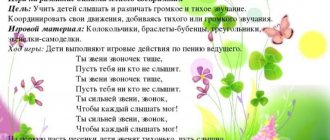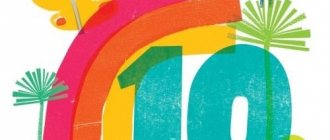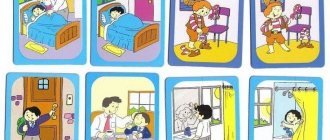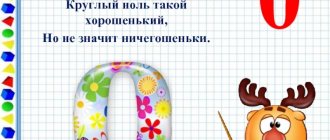Interactive game for children of senior preschool age “Musical Pages”
This resource is intended for children of senior preschool age, but in practice we used it with children of middle preschool age and with children in the group with mental retardation.
This manual includes games and riddles aimed at consolidating knowledge on the topic “Musical Instruments” in a playful way. “Find the extra” Goal: to consolidate the ability to classify and generalize knowledge. children are offered 4 tasks, the child chooses:
Task No. 1 (trombone, flute, pipe, horn, violin) An image of musical instruments appears on the screen, the child must identify the extra instrument, when choosing the wrong answer, the child hears the phrase “Think”, and the image does not disappear, only sways. When choosing the correct answer, the child hears the praise “Well done!” and the extra tool disappears from the screen. To continue, you need to press the arrow to the right; if the child wants to return to the main page, you need to select “House”; if there is a rounded arrow on the task selection page.
“Musical chest” Purpose: to consolidate children’s knowledge of musical instruments, groups of musical instruments, to stimulate auditory attention.
Children are invited to listen to a fragment of the sound of a chosen musical instrument. It is especially interesting for a preschooler to hear the sounds of the chosen musical instrument.
Puzzles. Goal: acquaintance with musical instruments through folk art. The riddles are voiced, the child hears, guesses the riddle and sees a picture - the answer, hears the word and is sure to receive praise.
The games include animation effects, which makes it possible to improve feedback with children and provide more comfortable conditions for conducting classes and an individual approach to learning, allowing you to show the world of music much richer and brighter, and connect visual and auditory ideas.
It should also be taken into account that the duration of classes using a computer for preschool children is in accordance with the requirements of SanPiN.
cannot exceed 7-10 minutes. For the full text of the material Interactive game for children of senior preschool age “Musical Pages”, see the downloadable file
. The page contains a fragment.
| Author: Khvoina N. M., Tveritina G. G. → Publisher 08/18/2017 2 12693 2171 | Comment |
Thank you for your mark. If you want your name to be known to the author, log in to the site as a user and click Thank you again. Your name will appear on this page.
Login | Registration
Have an opinion? Leave a comment
Consultation for parents “Musical games in the family”
Valentina Trubenkova
Consultation for parents “Musical games in the family”
Play is the main way of teaching and educating preschoolers.
In play, a child develops as a personality, he develops those aspects of his psyche on which the success of his educational and work activities, and his relationships with people in the future will depend. Musical play is an important means of developing musical activity. Musical games help to instill a love of music , interest in the basics of musical literacy , arouse interest and desire to participate in them. As a result, the child learns to love, appreciate, understand music and receives the necessary knowledge about the basics of musical literacy .
In my teaching work, musical games in classes, at holidays and entertainment, and in the independent activities of a child in kindergarten. For the musical education and development of a child in the family , I want to offer you, parents , simple musical games . these games either together, for example, a child and mother, or with the whole family at home , on family holidays, or on the way to kindergarten.
“COME UP WITH WORD NOTES”
Participants in the game take turns coming up with words containing combinations corresponding to seven notes and pronouncing them out loud. The result should be a series of words. For example: house - radish - bear - apron - salt - frog - tit.
"SONG-DANCE MARCH"
The first participant names any genre of music , the second participant must depict it with movements (if it is a march or dance)
or sing a song
(if the genre is song)
. After completing the task, the second participant names the genre, and the next participant shows the genre, etc.
"APPLAUSE"
One of the simplest music games is to remember a missed rhythm. The first participant comes up with a simple rhythm and claps it. The second participant repeats and comes up with a different rhythm and claps. And so on.
"KNOCKERS"
This game requires musical instruments . If there are no musical instruments at home, objects that can be used to produce sound are suitable, for example, metal cutlery, cubes, etc. It is advisable to use materials of different timbres - wooden boxes or plastic boxes, metal cans and pans. You can hit them with metal sticks or spoons.
The first participant comes up with and “ loses ”
rhythm on objects, for example, using iron sticks to tap part of the rhythmic pattern on a wooden surface, and part on a metal surface. The second participant repeats the rhythmic pattern using the same objects and timbres.
“WE WILL SING A SONG IN A CHAIN”
The game uses songs that everyone in the game , such as children's songs from cartoons. The first participant starts singing the song and sings the first line, the second line of the song is sung by the next participant, and so on. The goal of the game is to sing a song without stopping.
"SOUNDS AROUND US"
Participants listen to the sounds that surround them and take turns singing. For example, a participant says that he hears the rumble of a flying plane and sings with one sound: ooo-oo-oo-oo, the participant also depicts with his voice an airplane approaching and flying into the distance, gradually strengthening and weakening the sound.
"TAKE A SEAT"
It is advisable to play this game with a large family . This is the most favorite game of children. Several chairs are placed in a circle in the middle of the room; the number of chairs depends on the number of players and should be one less. The host turns on cheerful and rhythmic music , the players run around the chairs, and when the music ends, the game participants sit on the chairs . Anyone who did not have time to take a chair or sat by must leave the game . One chair is removed along with it. The game continues until one player remains with one chair.
The game can be varied with movements. Running can be replaced by straight and side gallop, round dance, dance movements, and instead of running, you can convey the image of an animal or other fairy-tale character in motion,
"LOUD QUIET"
For the game, 2 identical objects are suitable, but different in size, for example two cubes: large and small. The first participant sings an excerpt of the song, and the second must show with the help of an object how the first participant sang: a large cube - loudly, a small cube - quietly.
Another version of the game . The first participant shows a small cube, the second participant must quietly sing a song or sing his name. The second participant shows a large cube, the next participant must perform a song loudly or sing his name.
"GUESS THE MELODY"
The first participant sings the melody of a famous song in any syllable (la-la-la, na-na-na, the second participant must guess the name of the song. After the correct answer, the second participant makes a melody for the other participant and sings it, etc.
"CONTINUE"
Themes for this game are varied : these can be the names and surnames of composers (Ludwig van Beethoven, Johann Sebastian Bach, Wolfgang Amadeus Mozart, Pyotr Ilyich Tchaikovsky, Nikolai Andreevich Rimsky-Korsakov, Vladimir Yakovlevich Shainsky, etc.); names of musical works by one composer (P. I. Tchaikovsky “Children’s Album”
, consisting of several
musical works : “March of the Wooden Soldiers”
,
“Doll’s Disease”
,
“New Doll”
,
“Waltz”
,
“Polka”
,
“Mazurka”
,
“Nanny’s Tale”
,
“Baba Yaga”
,
“Song of the Lark”
and etc.);
name of musical instruments (guitar, drum, tambourine, etc.)
;
words that characterize the emotional and figurative content of the music (joyful, thoughtful, leisurely, etc.)
;
name of notes (do, re, mi, fa, sol, la, si)
;
name and display of musical, rhythmic and dance movements (running, galloping, jumping, polka step, round dance step, side step, etc.)
.
For example, you decide to play on the topic of composers, then the first participant in the game names the name and surname of one composer, the second participant of another composer, the next one of the third composer, etc. Here is another option on this topic: the first participant calls the name and patronymic of the composer, the second participant should say his last name. After the correct answer, the second participant names the first and patronymic of another composer, and the next participant names his last name, etc.
Thank you for your attention!







